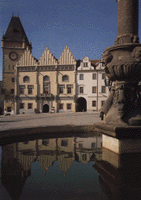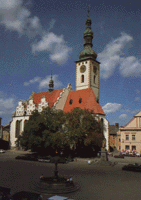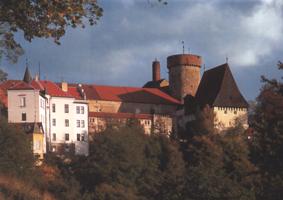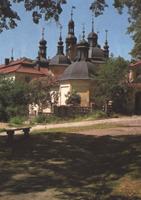The town of Tábor

The town arose on a very favourable spot. The river Lužnice, which collected the waters of the Tismenický stream and other tributaries, flowed round the south side and together with rocky cliffs and fortification walls created a stronghold which was impregnable during and after the Hussite period. The insufficient supply of drinking water, however, forced the people to dam the Tismenický stream, re-named Jordán, with a wall over 280 metres long and about 20 metres deep. thus creating the Jordán dam. The dam wall made access to the town very difficult, especially in later wars. After 1830 the dam was never emptied and fishing it out was done for many decades by net. Today it covers just under 50 hectares and measures 12,7 metres at its deepest point. The first waterworks were built bellow the dam sometime before 1509. An inggenious and, at that time, unique device pumped the water to a height of over 32 metres into a water tower in the town walls from where it supplied seven fountains, one of which still functions today.
The town had altogether 70 streets, alleya and squares. The way these tortuous streets were built indicated that, in case the town walls were stromed by the enemy, the Hussite builders of Tábor had planned to turn the town into a military stronghold in order to be able to continue the fight against invaders. It has been proved that the complexity of the town's ground plan was due to the fact that the Hussites who came in 1420 to build their refuge made use of the castle standing here and the remains of the 14th-century settlement of Hradiště.
Nothing has been preserved of the original Hussite Tábor apart from relics found by archaeologists below the surface of the present town. The buildings of today arose mainly after great fires in 1525, 1532 and 1559. The cores and exteriors of several houses are late-Gothic but mostly they are Renaissance, whilst Baroque, Rococo and Empire styles have made little mark on the town.

The Town Hall on the east side of Žižka Square is a late-Gothic building, started at the end of the first half of the 15th century approximately at the same time as the Church of the Transfiguration and finished in 1521. In 1679 it was remodelled by Antonio da Alfieri and given a neo-Gothic aspect in 1876-1878 by Josef Niklas. It is a two-storeyed building with a large corner tower, a stone balcony supported by corbels runs arround the courtvard, the extensive hall on the ground floor was called the lower palace. The halls of the Town Hall are used by the Museum of the Hussite Revolutionary Movement for its collections which contain several original objects as well as copies and models. At the Town Hall there is the entrance to part of the underground cellars and passages under Žižka Square about 600 metres in length. They are hewn out of rock and linked together, in some places with two to three floors.
Standing in the centre of Žižka Square is the Renaissance stone fountain dating from 1567 - 1568 by Master Ondřej of Sušice. It symbolizes the town's right to a market. The sandstone monument to Jan Žižka from 1884 is the work of Josef Strachovský, made to replace the earlier statue of the Hussite commander by Josef Václav Myslbek.
Tábor went through several social and economic changes to the mid-16th century, the revolutionary common ownership of property was abolished, the composition of the population changed, specialized crafts flourished. In 1436 the Tábor people recognized Emperor Sigismund as King of Bohemia and the ruler issued an Imperial Charter raising Tábor to a royal town. But not long after the people again opposed Sigismund and his successor King Albert II. Neither did they submit to the provincial administrator, Jiří of Poděbrady who besieged the town in 1452 and then Tábor capitulated. In 1460 King Jiří confirmed all the town's privileges.
Up to 1547 Tábor enjoyed considerable economic prosperity. A large part in this was played by craft production, particularly cloth-making, but above all by the extensive land owned by the town. But in the War of Schmalkalden the people of Tábor refused to help in the fight against the German Lutherans as required by King Ferdinand I and were punished in the form of confiscation of the town's property and a high financial penalty. The town fell into debt and had great difficulty in dealing with this situation.
At the end of the 16th century Tábor like other Bohemian towns suffered an economic decline. The obligations to the crown grew heavier, the large estates presented strong competition and craft stagnated. The following century brought also difficult times. In 1611 the surprised population opened the gates to the Passau army without any opposition and even worse was to come after the defeat at the Battle of the White Mountain. Tábor stood on the side of the Czech Estates in their rebellion and for a whole year, until November 18, 1621, it managed to defend itself against the Imperial forces. It capitulated only when food and ammunition became scarce. The property of the townspeople and of the town became the war booty of the victorious armies, the town's estates were confiscated. The capture of Tábor by the Swedes in 1648 brought further suffering and destruction, the town was economically ruined, half the houses abandoned and the number of inhabitants severely reduced.

In the 15th and particularly the 16th century settlements grew up outside the town walls, above all on the east side, and continued to the 19th century, trough not to a great extent. Palacký Street, the main suburban road, was built in 1861. The new parts of Tábor were founded after 1871 when the railway line from Vienna to Prague via Tábor was opened. Work was begun on building up extensive spaces between the old core of the town, the adjoining suburbs and around the railway station. A malt-house was built near by in 1872 - 1873 and, going towards the town, an extensive tobacco factory (1881 - 1882), which was the largest industrial enterprise in the town for many decades. The factory was closed down after World War II.
Tábor gained in importance when the railway line to Jihlavawas opened in 1888 and to Písek in 1889. The Tábor - Bechyně electrified railway line, the first of its kind in Bohemia, was opened in June 1903, mainly due to the firm of Ing. František Křižík of Prague.
The development of education facilities played a significant part in Tábor's history. It built its own technical high school, opened in September 1862, the first in the former Monarchy, with teaching exclusively in the Czech language. In November 1866 the Czech higher school of economy and provincial economic-technical school were opened and in 1900-1919 the Academy of Agriculture which became known outside the frontiers, due to the many students from Slav countries.
Industries began to develop gradually in Tábor, especially food, textiles, paper, wood-processing and engineering, and this continued and gained momentum after World War II.

Tábor, situated in the Tábor hilly country, is the economic, administrative and cultural centre of the region; it is an important road and railway junction. New housing estates and factories have arisen and old ones been modernized. In 1961 the ancient core of the town was declared an urban reservation and in 1962 the first to be declared a national cultural monument.
Welcome in Tábor
Recommended options: